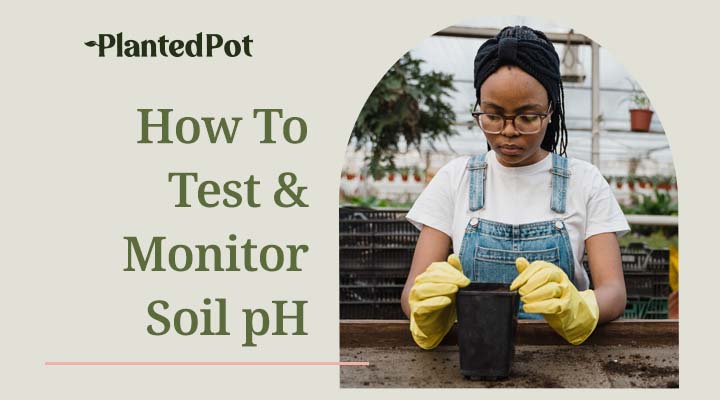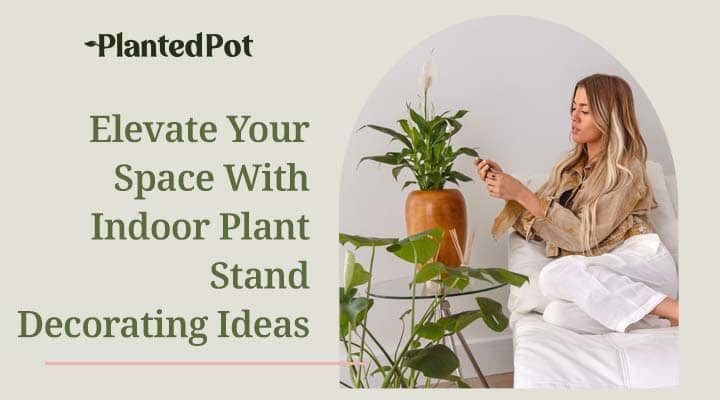
- Indoor Ferns: The Best, Most Popular, & Easiest to Care For Ferns!
- Greg Poblete
- June 11, 2021
- 2:27 pm
- No Comments
Indoor Ferns: The Best, Most Popular, & Easiest to Care For Ferns!
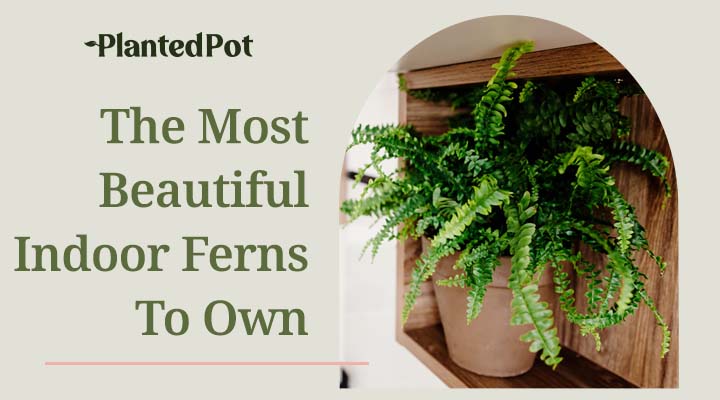
Indoor Ferns: The Best, Most Popular, & Easiest to Care For Ferns!
Indoor plants can bring one a sense of peace while connecting to nature, make for exquisite decor in any room, and get a feeling of accomplishment after successfully growing an indoor plant. Indoor ferns, in particular, are among the most popular indoor plants out there.
Ferns can take many different shapes, grow up to many different sizes, and come in various colors and patterns. We will explore the nature of the fern plant, some benefits of indoor ferns, a few types of indoor ferns, and which ferns are pet-friendly.
What Are Indoor Ferns?
Indoor ferns are beautiful, lush house plants one can find. Ferns make for great decoration and add vibrant color to any room. No matter what kind of fern you choose, they match well with other house plants so that you can create your own little garden right in your own home!
Ferns are incredibly versatile and have been a staple in home decor since the Victorian era. Ferns are flowerless plants that have a diverse range of foliage, colors, and leaf textures. Many ferns give off a tropical vibe with their eccentric leaves, while other ferns are a bit more subtle and thrive in the background.
What Are the Benefits of Indoor Ferns?
Aside from looking pretty on your bedside table or bookshelf in the living room, indoor ferns and plants have a handful of potential benefits.
Reduce Stress
According to a study done by the Journal of Psychology, indoor plants can help with reducing your stress levels. Indoor plants, including ferns, can create a more comfortable, soothing, and natural environment that can calm you down exponentially.
Sharpens Your Attention
Another study conducted by Konkuk University used 23 participants to see who would retain the information better in the presence of a fake plant, a photo of a plant, and a real plant. The study showed that those who studied in the same room as the real plant were more attentive than the participants in the other rooms.
Therapy
Indoor plants are beneficial to those who experience symptoms of mental illness. The process of indoor gardening demonstrates therapeutic and calming effects. In fact, medicinal experts in Manchester, England, have prescribed potted plants to patients with signs of depression or anxiety.
Increase Productivity
In addition to sharpening your attention span, indoor plants can boost your productivity. Countless studies have found classrooms with indoor plants present resulted in students working faster and less stressed.
Improve Air Quality
Another huge benefit to having indoor plants is the improvement of air quality. Research has shown that having indoor plants can help get rid of toxins like carbon monoxide, formaldehyde, benzene, or xylene in your home. Although some indoor plants have different properties for improving the air quality, a Boston Fern is just one example of an indoor plant that can help you breathe better inside.
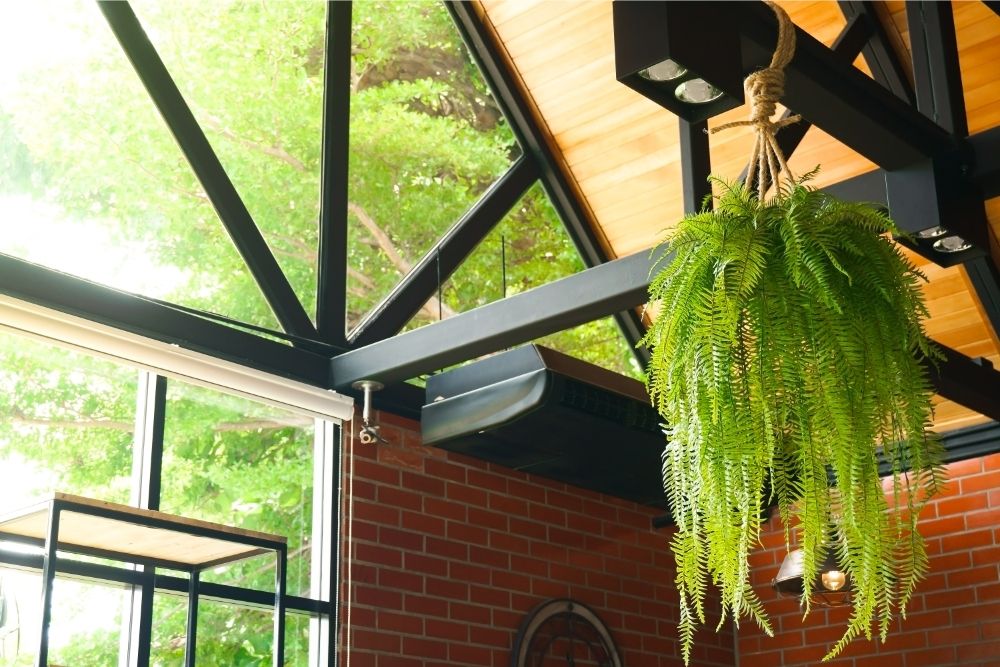
Are Indoor Ferns Easy to Care For?
Every type of indoor plant is unique and has its own specific requirements for growing. But for the most part, ferns are relatively easy to care for.
Most ferns growing indoors require medium to bright light away from direct sunlight to avoid sunburn, enough water to keep the soil moist, and an average amount of humidity.
What is the Easiest Indoor Fern to Care For?
If you are searching for an indoor fern that won’t give you any stress, here are some of the easiest ferns to take care of!
Lemon Button Fern
The Lemon Button Fern is an excellent beginner plant because it is “drought tolerant.” Although the Lemon Button Fern needs moist soil to grow, it won’t instantly die if you forget to water it after a few days.
The Lemon Button Fern is a fun and charismatic indoor plant with small bright green leaves and can grow up to 30 cm. This plant gives off a lemony aroma that will bring you back to those warm summer days.
Boston Fern
The Boston Fern encompasses many fern plants, such as the Delilah Boston Fern, Florida Ruffle Boston Fern, and the Compact Boston Fern. Boston Ferns are popular among beginners because of their compact size and how easy they are to take care of.
Boston Ferns have long, drooping leaves that grow best from a hanging pot near a window. Forgetting to water this plant won’t lead to instant death, but you may notice some leaves dry up or fall off. But overall, Boston Ferns are long-lasting plants and will provide plenty of color in your life.
Bird’s Nest Fern
The Bird’s Nest Fern is the perfect plant for those who do not live in an area with humidity. Like the other ferns, this plant can survive without a couple of watering days and does well either indoors or outside. The Bird’s Nest Fern resembles a bird’s nest with sprawling, crinkled leaves, and vibrant green coloring. The Bird’s Nest Fern is an eye-catching plant that will you chirping with joy.
Types of Indoor Ferns
Aside from the easy-to-grow ferns such as the Boston Fern and the Lemon Button, here are a few more popular indoor ferns that promise plenty of charm to any room.
Maidenhair Fern
Delicate yet bold, the Maidenhair Fern is a beautiful plant with lacy green leaves that can brighten up any living space. Although a bit more difficult to take care of than most ferns, the Maidenhair’s elegance is worth the effort. The Maidenhair Fern requires bright, indirect sunlight and a temperature of 60-70 degrees Fahrenheit. The soil of the Maidenhair Fern should be moist but not too soggy to ensure it receives the most nutrients.
Rabbit’s Foot Fern
A rather chaotic and wild-looking plant, the Rabbit’s Foot Fern is a unique specimen that proudly displays its quirks for everyone to see. The leaves shape of the Rabbit’s Foot Fern takes the shape of a triangle to resemble an actual rabbit’s foot. This beast of a fern is relatively easy to care for, requiring bright indirect sunlight, light watering enough to keep the soil moist, and a balanced fertilizer given monthly.
Kangaroo Paw Fern
Another fern named after an animal’s foot, the Kangaroo Paw Fern, is a wild and eccentric indoor plant with its unhinged leaves stretching all over. An export from Australia, the Kangaroo Paw Fern can reach up to two feet tall while spilling its leaves over the side. The Kangaroo Paw Fern does best in medium to bright light with average humidity. The dark green foliage of this fern can be a great partner plant to a lush indoor garden or a fun centerpiece.
What Are the Best Indoor Ferns?
If you truly want to wow your friends and family with your indoor plants, here are some of the most extraordinary and eye-catching indoor ferns you can get.
Staghorn Fern
Staghorn Ferns are unique compared to other ferns because they don’t require soil to grow. The Staghorn Fern are epiphytes which means that they grow on trees and wood pieces. Because the Staghorn doesn’t need soil, this makes taking care of this plant a breeze. You can water the Staghorn as if you were to water an air plant by fully submerging the plant in water and letting it dry.
The wonderful thing about the Staghorn Fern is that this plant is truly versatile in that you can place it almost anywhere in any pot, and it will thrive. You can hang them from the ceiling or as a wall mount and watch your Staghorn grow beautifully sporadic leaves.
Frosty Fern
The Frosty Fern is a more subtle beauty with its white-tipped leaves resembling fallen snow. However, it is important to note that the Frosty Fern isn’t technically a fern and that this plant is part of the spike moss family. The Frosty Fern is known as a “fern ally,” taking on similar characteristics of a fern, such as reproducing via spores.
The Frosty Fern can grow up to eight inches, making it a nice and compact plant you can place on an end table or desk. These plants enjoy lots of humidity, so a terrarium may be the best way to grow a Frosty Fern.
Foxtail Fern
As you can guess by the name, the Foxtail Fern is a beautiful plant with scraggly leaves that take the shape of a foxtail. Foxtail Ferns have a bright, light-green coloring that pops no matter where it is placed.
The Foxtail Fern enjoys bright indirect light and prefers temperatures around 75 degrees Fahrenheit. Weekly watering should suffice for this plant, and fertilizing once a month is recommended. This fern is a showstopper and will guarantee to turn heads.
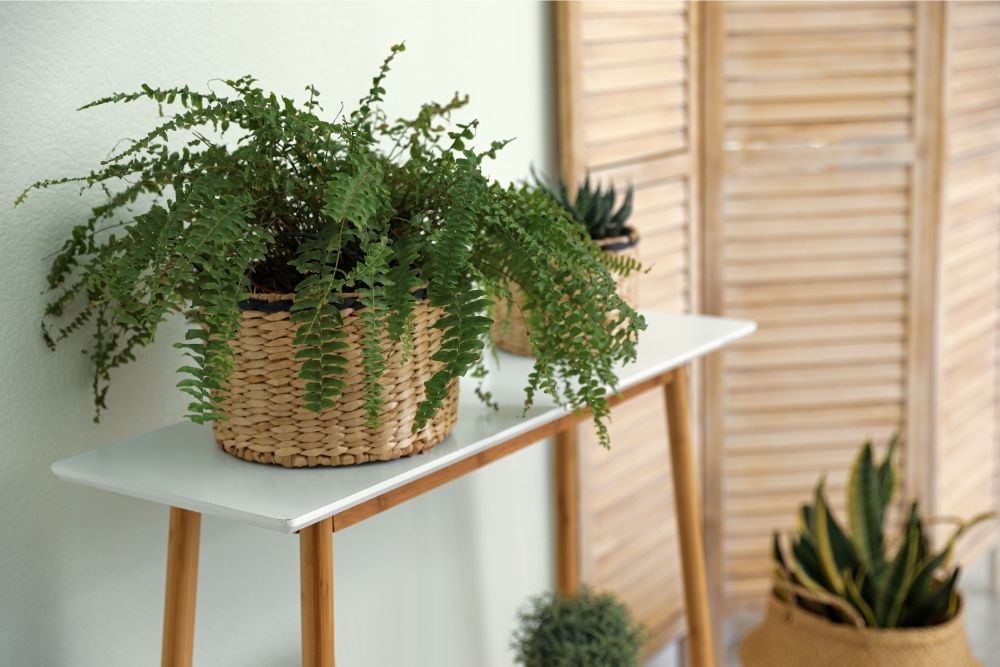
How to Tell if Your Indoor Fern is Dying
There are several signs you may notice if your indoor fern is on the verge of dying. Some signs include the leaves browning, wilting, or falling off, the plant is drying up, and your fern stops growing completely. There are a few explanations for all this.
Not Enough Humidity
Depending on the type of fern you are growing, you may need to bump up the humidity levels to their liking. Most indoor ferns require a humidity level of about 30-50%. Anything below that threshold, your fern may struggle to stay alive.
A possible solution to not having enough humidity is investing in a humidifier or a terrarium to accurately control how humid the environment is. Having access to one of these can be incredibly useful, especially during the winter when the weather is cooler, and the humidity levels are lower.
Too Much Sunlight
Certain ferns can thrive in sunlight, but many others prefer indirect light, or else their leaves will brown and wilt away. The best solution to avoid having too much sunlight is to find a place in your home that gets some light, but not an overbearing amount. The ideal spot would be near a north-facing window.
Not Enough Water
Although plenty of ferns can survive a few days without water, there is a point when the roots can completely dry up. On the other hand, overwatering may cause root rot and bring about fungal diseases.
The ideal solution to watering your fern is to make sure the soil is moist but not too moist. The best practice is to check in with your plants every so often to ensure that it is not drying out and growing at a healthy rate. Allow the first couple of inches of soil to dry out before watering again.
Over Fertilization
In general, ferns don’t need to be fertilized that often during the growing process. Adding too much fertilizer can cause the plant and roots to burn, and the leaves can fall off. In some cases, your plant may die.
As a rule of thumb, you should only fertilize your plant about once a month during the growing seasons. This should be enough to provide your fern with the proper nutrients it needs to grow.
Which Indoor Ferns Are Pet Friendly?
If you have any pets that enjoy getting into your plants, it is important to know whether or not your ferns are pet-friendly. Some indoor plants can be toxic to animals and can cause vomiting and diarrhea if accidentally ingested. Here are a few ferns that are non-toxic to your furry friends and absolutely considered pet friendly plants.
- Asparagus Fern
- Bird’s Nest Fern
- Boston Fern
- Dallas Fern
- Foxtail Fern
- Holly Fern
- Lemon Button Fern
- Maidenhair Fern
- Rabbit Foot Fern
- Staghorn Fern
Final Thoughts – Indoor Ferns
Indoor ferns can make fantastic decor while also rejuvenating the air you breathe inside. Ferns can be fun to collect and mix and match with your other houseplants. So whether you enjoy the bushy look of a Boston Fern or the elegance of the Maidenhair Fern, there is a fern out there for you!
Subscribe To Our Newsletter!
Get Exclusive Discounts & the Latest News Sent to your inbox!



